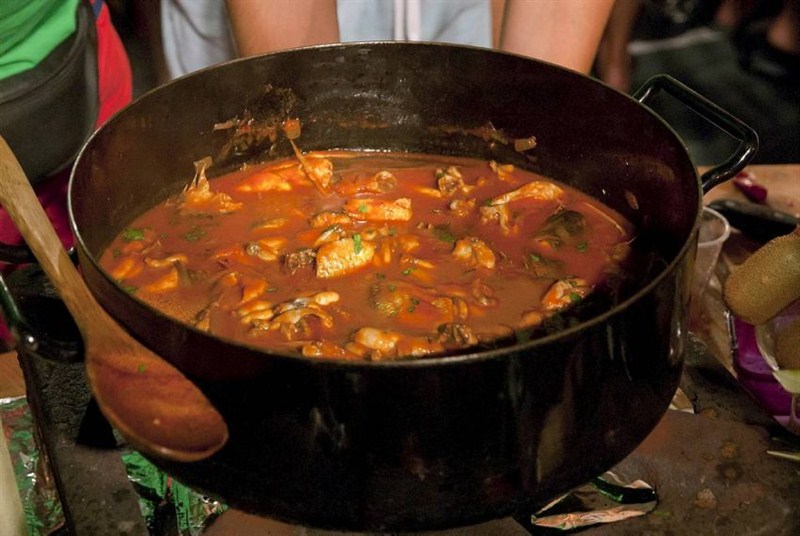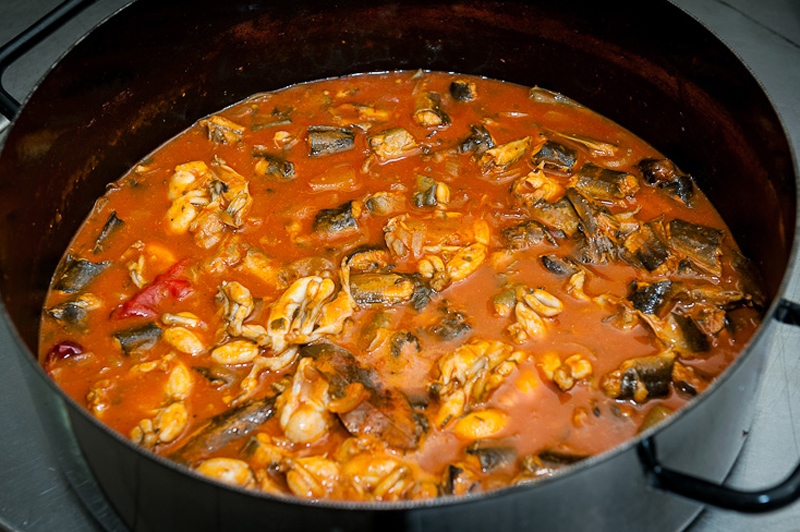For centuries, the sea has been a vital resource for the people of the Mediterranean. The Adriatic is bursting at the seams with fish – from meaty swordfish and tuna to sardines, red mullet and more. As you travel around the region, you’ll see an abundance of fresh fish and seafood in Mediterranean restaurants and markets. The Adriatic is a rare case of quality and quantity going hand in hand, too – its fish is high-grade. Mediterranean seafood stew – brodet was in history one of the simpler and very popular ways of preparing fish.
There are several names for this dish in the Croatian language – all are very similar but different due to dialectal varieties. The most common ones are brodet, brudet and brujet, while one almost forgotten version would be bujabiž. All those names are derived from foreign languages. Hence, brodet (brudet, brujet) comes from the Italian brodetto while bujabiž comes from French bouillabaisse. The meaning of them all suggests some sort of a soup made of fish and/or seafood.
Stew, however, is much heartier and thicker than soup, and the ingredients are chunkier, too. Stew in general is any dish we prepare by stewing; that is, submerging the ingredients with just enough liquid to cook them through at a simmer in a covered pot for a long time. While the overall dish includes liquid, it contains just enough of it to cover the main essence.
The Secret Behind Brodet
Brodet, brudet or brodetto is a seafood stew popular in the Croatian regions of Dalmatia, Kvarner and Istria. It is normally prepared of several types of fish stewed with spices, vegetables and red or white wine, or even vinegar to keep the flesh of the fish consistent. Its inevitable ingredients would be olive oil, salt and pepper, onions and garlic, parsley and peeled tomatoes. In most cases the finest brodet is made of grouper, scorpion fish, frogfish (monkfish), sea bass, sea-bream, eel, conger and John Dory.
The most important aspect of brodet is its simplicity of preparation and the fact that it is typically prepared in a single pot. You can serve it with polenta or toasted bread, which soaks up the fish broth, while other recipes serve it with potatoes, beans, cabbage, or bread. Brodet originated among fishermen who would cook their meals at sea with part of their catch – small fish of no commercial value or damaged by the nets – and the few condiments available on board.
There are many traditional recipes, but what follows is one of the more common ones. First, warm up some olive oil on the bottom of a wide dish. Next, come chopped onions. You add them on warm, but not hot, oil. When onions release their juice and get a golden colour, it is time to add a few tiny-cut cloves of garlic, ground black pepper, tiny cut parsley and one large bay leaf. After another few minutes of simmering, the ingredients should fuse. After putting pieces of fish into the dish, add as much water as necessary to cover it. Keep the fire moderate, just enough for the dish to slightly boil. Add some salt and leave it like that until the water evaporates and the sauce gets dense. Before you decide that your brodet is ready, you can pour half a glass of red wine into the dish. The other half is for you as a reward if the taste and consistency are satisfactory.
One Meal – Hundreds of Different Tastes
Although the Croatian Adriatic is a relatively small part of the world, there are hundreds of different tastes of brodet. Each variety of this dish tells you a story about a certain area and its history, about chefs, their family heritage and invention. Brodets can significantly vary in the preparation style, flavour, the ingredients used and cooking styles applied. Many chefs combine fish with crabs and shells, adding their own combinations of spices, using secret tricks…
Therefore, brodet prepared in the south Adriatic and Dubrovnik region would have a sophisticated and rich taste prepared with grouper fish, while one from the mouth of the river Neretva is inconceivable without eels and frogs, slightly burning your mouth with local chili peppers. On the island of Vis, on the other hand, brudet contains beans, and the main fish used is conger. The islanders from Central Dalmatia in general like to prepare brodet with squid, cuttlefish and octopus. Those from the coast however stick to scorpion fish, frogfish and conger.
Depending on the social status, brodet has showed different faces throughout history. The dish prepared with a lobster’s head could be seen on the tables in noblemen house. The poor, on the contrary, had to help themselves with what they had. Therefore, it makes sense that brodet is not easy to describe – it has to be prepared and tasted, so let’s do it!

Other Mediterranean Seafood Stew Variations
Italian seafood stew, brodetto di pesce, or simply brodetto, is the signature dish of almost all Italian Adriatic coastal cities. In the beautiful fishing town of San Benedetto del Tronto, brodetto incorporates green tomatoes and peppers. Further north, in Pesaro, you will find a more traditional brodetto, made with plenty of ripe tomatoes. On the other hand, brodetto di Ascoli in the south arrives without a single tomato inside, laced instead with strings of golden saffron. Brodetto all’Anconetana must contain thirteen different types of fish and seafood from the sea of Ancona, though the reasons differ. Some believe it has religious origins, commemorating the thirteen participants of the last supper, but others say it represents the thirteen masks of the Fontana del Calamo – the ancient fountain in the middle of Ancona.
engine to help you…
A similar dish in Greece, from the island of Corfu, is known as bourdeto. It is fish cooked with onions and red sweet and spicy peppers, making it some sort of spicy fish soup. The fish used for bourdeto is scorpionfish. The original recipe never used any tomatoes or tomato sauce, but some chefs nowadays use it to make it softer and more attractive to tourists. In Greece, this meal is called bourgeto. An interesting fact is that in Zakynthos, bourgeto is a meat dish. Here, meat is the main ingredient instead of fish. Portuguese seafood stew composes of squids with a few seashells. In Spain, seafood stew contains octopus, topped with chorizo sausages and a little bit of bacon. With this in mind, it’s safe to say that brodetto is the iconic seafood meal of Mediterranean cuisine.
Where to Taste the Best One?
If all this talk made you hungry, you should definitely hop on a boat and head out to Jorja bay, a nice shelter for your yacht and tastebuds on the island of Šolta, where they serve probably the best brodetto on the Adriatic. “Kike” is a small, local family-run tavern and the best place to eat seafood if you are nearby. Due to the fact that the only way to get to the restaurant is via a boat, be sure to make a reservation in advance with Kike, the owner. Although he has set up a system of mooring lines, there are only so many boats that can fit in Jorja Cove and so many people who can sit on his terrace.


Making this for dinner!
I am fortunate that I will be able to spend more and more time in Croatia. For while I am away, brodet (your recipe) can tide me over. Thank you!